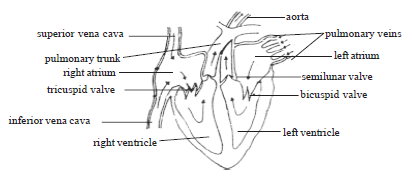Heart is a pumping organ. It receives blood from different parts of the body through the veins that open through inferior and superior vena cavae and pulmonary veins. While the right atrium receives deoxygenated blood, the left atrium receives the oxygenated blood from the lungs. When the wall of the atria contract the right and left atria pump the blood into the right and left ventricles respectively. A pulmonary trunk arising from the right ventricle takes away the blood to the lungs for oxygenation. The left ventricle gives rise to an aorta, from which oxygneated blood is supplied to the coronary arteries and the systemic circulation of the body.

The blood flow between the right atrium and the right ventricle is regulated by the tricuspid valve. The bicuspid or mitral valve regulates the flow on the left chambers of the heart. In the pulmonary trunk and the aorta, back flow of blood is prevented by a set of semilunar valves.